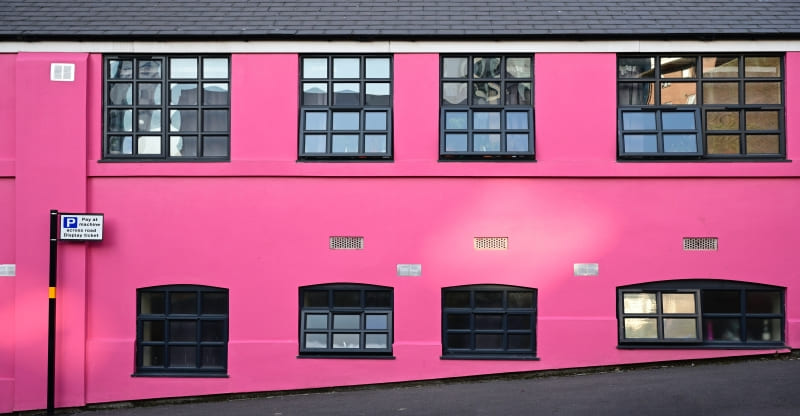Lettering in Architecture: How to Write Like an Architect
What is the Architectural Lettering Style?
This is a script used by architects to communicate and clarify their designs. The block letters are consistent and readable at a glance. Legibility is much more important than speed or artistic flair for this lettering. You’ll use architectural script on all sorts of documents for design and construction. These include blueprints, plans, drawing mockups, and more.
Why Does it Matter?
The architectural script lets the architect or designer turn their vision into actionable plans. You use it to explain things like:
- how something is assembled
- placement and orientation
- materials to use
- measurement targets to hit for code
Of course, you can also do that with your regular handwriting. Why bother learning another form of script? Well, legibility is key.
Architectural lettering was first developed when multiple people worked on the same set of paper plans. However, it was hard for contractors to read a mix of italics, blocky capitals, fancy cursive, and whatever the last guy wrote in smudged pencil. This is still true. Even if you’re the only creator of a document, one sloppy character can cause trouble.
What if the contractor misreads your 50” as 60”? It could turn into:
- safety issues
- wasted materials
- missing deadlines
- exceeding the budget
- rejected permits
- failed inspections
Architectural lettering lets you get your intent across with no ambiguity.
A lot of schools no longer teach this lettering because we’re in the digital age, right? When you’re doing most of your drafting digitally, you can pick any legible font. However, there’s a good chance that someday you’ll need to make on-the-spot corrections or clarifications. There won’t always be time to get out your tablet, adjust the text, and reprint everything.
Finally, architecture and design are really competitive fields. Good, clean lettering sets your design ahead of the competition. It clearly shows the client that you’re invested and take pride in your work, with no cut corners.

What Makes Good Architectural Lettering?
I’m about to jump into a lot of points. Keep in mind the two key points are consistency and legibility. You’re aiming for letters, usually all capitals, that look the same. Your words should be evenly spaced apart. Don’t forget to clearly differentiate between easily confused numbers and letters like:
- A, 4
- S, 5
- C, G
- D, P
- T, 7
- I, J, and 1
- O, Q, and 0
Some architects differentiate by putting a dot or slash in the number 0. Others make a triangle shape for A. For the most part, you can keep these distinct by practicing good lettering skills.
How big should the letters be? If you work for a design agency, follow their guidelines. In general:
- 10-12mm for title block and cutting plane notes
- 6-8mm for drawing titles
- 4-6mm subtitles
- 2-3mm for your various notes, alterations, tolerances, etc.
If that’s confusing, just memorize 12-8-6-3. Your title block is the biggest, and everything else steps down from there.
Ready to Learn an Architectural Alphabet?
Get Your Supplies
You’ll need a basic architectural lettering practice book. If you’re taking architecture and design classes, do you already have Architectural Graphics by Frank Ching? He includes a section on lettering. Otherwise, David Chappell and David Scott-Kings have published multiple books on this subject.
Next, assemble your supplies. You’ll need:
- paper that’s thick enough to prevent ink bleed-through
- micro-point felt tipped pens like Sharpies, Copics, or something with a consistent line weight and flow
- a small triangle for vertical strokes
- (optional) tracing paper to trace letter forms in your practice book
- (optional) ruler to create letter height guidelines if you aren’t tracing
Start Practicing
Practice makes perfect, so it’s time to get to work. The core idea here is that every letter should be roughly square and distinct from each other. This means:
- Start every stroke from the top, while other lines run from left to right.
- Lift your pen between each stroke instead of letting the movements flow together. This creates more precisely formed letters.
- Vertical lines can be made with a triangle until you get the knack of hitting 90°every time.
- Horizontals and angles are usually freehand but aim for precision.
- Your curved forms like C and O will look like elongated ovals to make the letter more square.
- Keep your working hand away from the lettering until the ink dries so you don’t smudge it. You may also want to have a piece of scrap paper underneath, to protect the page from sweat and skin oils.
This lettering can seem really slow at first. Be patient with yourself and keep working on consistent letters. Speed will come as you build your muscle memory.

What About a Hybrid Approach?
Can you use a combination of computer drafting and hand-lettered notes? Of course! Just keep the ‘consistency’ part of ‘readability and consistency’ in mind.
If you’re learning architectural lettering from scratch, you can practice mimicking a typeface by tracing it. Otherwise, look for an existing font that’s a close match to the lettering you already know. Frank the Architect is a good starting point. This typeface is based on Frank Ching’s extremely clear and readable work.
What about using a second lettering style to add sophistication and pizzazz to your titles? Maybe you want to build a sense of intrigue, drawing the reader into your architectural vision. Papyrus is the font for you!
Just kidding. Never use Papyrus. It’s right up there with Comic Sans for unprofessional and overused typefaces.
For a more serious answer, look for fonts that balance readability with a memorable style. Tekton is a nice one. You might also want to look into Eaglefeather. This font was developed off of Frank Lloyd Wright’s iconic hand lettering. It’s more flowing and rounded than basic architectural scripts, and it includes Art Deco-themed letter variations.
Decorative fonts and lowercase letters can be used in noncritical areas of your design. These include the title and main headings. Clever use of a fancier but still readable font lets you add a wow factor to the design you worked so hard on.




